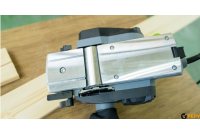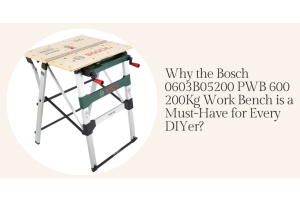How to Use a Wood Planer: Tips and Techniques

The wood planer is an essential tool for any woodworker. It smooths rough surfaces, joins boards seamlessly, and crafts wood to the correct measurements. To be a true planer expert, you must have extensive knowledge and experience in the proper setup, unwavering safety practices, efficient operation, and savvy troubleshooting. This all-in-one guide helps you master the wood planer with expert tips, techniques and insights.
1. Setting Up
Consider setting up your wood planer, such as tuning a guitar before a concert. It's crucial for good performance and safety. The initial step involves preparing your planer, wood, and work area for a smooth planing process. Let's break it down into three easy steps:
I. Get High-Quality Blades:

If your planer blades are dull, they can't do their job. Low-quality blades leave you with uneven, rough cuts and can be dangerous. Always check your blades. You'll need to sharpen or swap them for new ones if they're not sharp.
Then, set the blades to the cutting depth that best suits your project. This ensures the planer removes just the right amount of wood, leaving a smooth surface that needs little sanding.
II. Use an Adjustable Fence:
An adjustable fence is a lifesaver, if you work with lengthy wood pieces. Fastening it to one side of the planer acts as a guide to stop the wood from moving about during planing. This helps the planer stay on track, giving a smoother finish and reducing unexpected issues.
III. Keep Your Wood Stable:
Nobody wants shaky wood when planing. Secure your wood in a vise or clamp to stop it from moving. This ensures the planer stays in constant contact with the wood, leading to a smoother final result and a safer workspace.
2. Safety Considerations

Working safely with a wood planer is essential. It's the starting point for every successful woodworking task.
These tools need careful use with spinning blades and rollers, even by pro woodworkers.
A slight misstep can lead to an unpleasant situation. But, you can master safety as you master planing.
Let's look at three essential safety parts every woodworker needs to remember:
I. Dress Right (Safety First!)
Dust Mask: Your lungs aren't for filtering wood, so keep out the flurry of sawdust a planer stirs up. A quality dust mask is a shield, keeping those annoying particles from your lungs.
Hearing Protection: Planers aren't famous for their soft sound. They can bellow like a desert storm, especially in a closed workshop. Earmuffs or earplugs prevent hearing loss and let you concentrate on your work.
Safety Glasses: Small wood pieces and sawdust flying can damage your sight. Strong safety glasses protect your eyes.
II. What Not to Wear in Your Workshop
Loose Clothes, Gloves, and Jewellery: These items are better suited for a night out than woodworking. Loose clothes, hanging jewellery, or gloves can get caught in the planer's moving parts, potentially dragging your hand into the blades.
Bad Hair Day: If your hair is long, tie it back safely. You don't want your hair tangled in the machine, ruining a good hair day. Dressing safely is more than looking right; it's protecting yourself from potential harm.
III. Keep Clear of Danger Area
This might seem straightforward, but it must be stressed: never let your hands near the cutting spot when the planer is working. Those blades are sharper than a chef's knife and can cause severe cuts quickly.
Even when the planer is off, don't reach under the blades. It's a tempting shortcut that could be a disaster.
Always rest your hands on the workpiece sides, away from danger. After all, your hands are your best tools in the workshop.
3. Operating the Planer
Using a wood planer feels like being an artist in a power-packed performance. You turn rough wood into smooth, perfect pieces, but it takes knowing the proper steps. So, let's break these steps into five easy parts.
I. Starting the Planer:
Ensure the planer's power switch is off and unplugged. Then, plug it in and turn it on. Wait for the blade to spin at full speed before putting your wood piece on it. It'll only take 5-10 seconds.
II. Setting the Wood:
Gently place your wood piece on the feed table, with the side to plane facing up. Line the wood's front end with the planer blades, centering it on the table. The fence will keep it steady. Always keep your hands away from the spinning blades.
III. Feeding the Wood:
Now, the real work begins. Press the planer's front shoe on the wood, but avoid the blades. Push with the front handle to guide the wood to the spinning blades. When the wood hits the blades, lean in a bit, pushing harder on the front handle than the back. This stops the wood from lifting.
Keep even pressure on both handles, feeding the wood through steadily. As the wood nears the outfeed table, lean back, applying more pressure to the rear handle.
This prevents the tail end from lifting and creating a "snipe" or a dip at the end of the board. Only let go of the handles once the wood entirely passes the blades.
IV. Adjusting Cut Depth:
Cutting less is usually better. Make light, shallow passes, removing no more than 1/32 inch each time. Deeper cuts could cause the planer to leave unsightly marks.
To set the cut depth, turn the adjustment knob or lever. One complete turn usually equals about a 1/16 of an inch.
Don't make many heavy cuts at once; it can cause your piece to become uneven.
V. Feeding Direction:
Follow the wood grain, like following a river downstream. This makes a smoother finish. Going against the grain can lead to a rough surface.
If you must plane the end grain, go lightly and use a backup board to support the workpiece.
4. Troubleshooting
Wood planing, even when done carefully, can sometimes be tricky. Don't worry, though. Each problem is a chance to improve and sharpen your carpentry skills. Here's how to tackle three common issues that help you keep your work smooth:
I. Use Sacrificial Boards to Prevent Snipe:
Snipes, those irritating indentations or bumps on board ends, can ruin the perfection of your planing work.
A clever solution to this is to use 'sacrificial boards.' Placing a spare piece of wood at the start and finish of your piece will create a safe area.
Any snipe will impact these, ensuring your main piece stays perfect and clean.
II. Fix Saw Marks with Board Stacking:
Saw marks on multiple board edges can be annoying. But your planer can also act as a panel smoother.
By aligning your boards, you offer one surface that makes your planer smoother. So, you get sleek, uniform edges perfect for pieces that require a flawless fit. It's like giving your wood a group makeover.
III. Use Sanding to Remove Flaws:
Even the best planer blades can dull, leaving visible lines on your work. Don't lose hope; sandpaper and some effort can fix this.
Grab a 120-grit sandpaper sheet and subtly buff out those flaws, bringing back the wood's beauty.
Regular blade care can limit these problems, but sanding is a backup plan for unwelcome surprises.
FAQs
What's the key to optimal planer setup?
Sharp blades are important, as are accurate depth changes and sturdy material. Additionally, ensure your planer and fence are correctly aligned.
How do I prevent snipes when using a wood planer?
Use protective boards on each end, go for light strokes, and ensure the planer and the object are stable and straight.
What is best handling a wood planer with a large workpiece?
Use a mix of cauls and clamps to attach the workpiece tightly to the planer's table. This guarantees a flat, consistent outcome.
How do I maintain and sharpen my wood planer's blades?
Make it a routine to inspect, clean, and sharpen your blades with a sharpener or file. This ensures top-grade function, wards off harm, and preserves total efficiency.
What are some common mistakes to avoid when using a wood planer?
Avoid blunt blades, cutting too much material in one go, and ignoring fences or guides. Always put workpiece safety first and wear protective gear to avoid mishaps and poor results.
Final Words
Woodworking is not just a job; it's a form of expressing creativity, precision, and passion through the transformation of wood. Each stroke of the planer changes wood into art. FEPY, the leading e-commerce store in the UAE, offers different top-tier wood planers. They are safe, dependable, and cost-effective. Discover the ideal tool to unlock your creativity and create your next woodworking masterpiece!







